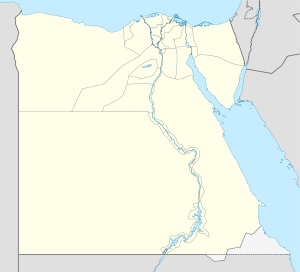- Faiyum
-
For other uses, see Faiyum (disambiguation).
Faiyum
الفيومLocation in Egypt Coordinates: 29°18′30″N 30°50′39″E / 29.308374°N 30.844105°ECoordinates: 29°18′30″N 30°50′39″E / 29.308374°N 30.844105°E Country  Egypt
EgyptGovernorate Faiyum Population (2006) – Total 316,772 Time zone EST (UTC+2) Faiyum (Arabic: الفيوم Fayyūm, Coptic: 'Ⲫⲓⲟⲙ Phiom) is a city in Middle Egypt. Located 130 km (81 mi) southwest of Cairo, it is the capital of the modern Faiyum Governorate. The town occupies part of the ancient site of Crocodilopolis. Founded in around 4000 B.C., it is the oldest city in Egypt and one of the oldest cities in Africa .
Contents
Name and etymology
![G40 [pA] pA](/pictures/enwiki/49/150px-Fayum-01.jpg)
![G1 [A] A](/w/extensions/wikihiero/img/hiero_G1.png)
![M17 [i] i](/w/extensions/wikihiero/img/hiero_M17.png)
![M17 [i] i](/w/extensions/wikihiero/img/hiero_M17.png)

![N35 [n] n](/w/extensions/wikihiero/img/hiero_N35.png)
![N35 [n] n](/w/extensions/wikihiero/img/hiero_N35.png)
![N35 [n] n](/w/extensions/wikihiero/img/hiero_N35.png)

pA-y-m (Faiyum)
in hieroglyphsIts name in English is also spelled as Fayum, Fayoum, Al Fayyum or El Faiyūm. Faiyum was previously officially named Madīnet el Faiyūm (Arabic for The City of Faiyum). The name Faiyum (and its spelling variations) may also refer to the Faiyum Oasis, although it is commonly used by Egyptians today to refer to the city.[1][2]
The modern name of the city comes from Coptic 'Ⲫⲓⲟⲙ /Ⲡⲉⲓⲟⲙ efiom/peiom (whence the proper name Ⲡⲁⲓⲟⲙ payom), meaning the Sea or the Lake, which in turn comes from late Egyptian pA y-m of the same meaning, a reference to the nearby Lake Moeris.
Ancient city
Main article: CrocodilopolisModern city
Faiyum has several large bazaars, mosques,[3] baths and a much-frequented weekly market. The canal called Bahr Yussef runs through the city, its banks lined with houses. There are two bridges over the river: one of three arches, which carries the main street and bazaar, and one of two arches, over which is built the Qaitbay mosque, that was a gift from his wife to honor the Mamluk Sultan in Fayoum. Mounds north of the city mark the site of Arsinoe, known to the ancient Greeks as Crocodilopolis, where in ancient times the sacred crocodile kept in Lake Moeris was worshipped.[4]
The center of the city is on the canal, with the four waterwheels, that are adopted by the governorate of Fayoum as its national symbol, their chariots and bazaars are easy to spot.
Faiyum mummy portraits
Portrait of a man, ca. 125-150 AD.. Encaustic on wood; 37 x 20 cm. Main article: Faiyum mummy portraits
Main article: Faiyum mummy portraitsFaiyum is the source of some famous death masks or mummy portraits painted during the Roman occupation of the area. The Egyptians continued their practice of burying their dead, despite the Roman preference for cremation. While under the control of the Roman Empire, Egyptian death masks were painted on wood in a pigmented wax technique called encaustic—the Faiyum mummy portraits represent this technique.[5] While commonly believed to represent Greek settlers in Egypt, the Faiyum portraits instead reflect the complex synthesis of the predominant Egyptian culture and that of the elite Greek minority in the city.
Undisputed remains of early anthropoids date from the late Eocene and early Oligocene, about 34 million years ago, in the Fayyum area, southwest of Cairo, Egypt. One of the earliest fossil primates at Fayum is Catopithecus, dating to around 35 million years ago.
Famous Sites
- Qasr Qarun, 44 km (27 mi) from the city
- Qaitbay Mosque, in the city, and was built by the wife of the Mamluk Sultan Qaitaby
- Hanging Mosque, built under the Ottoman Rule over Egypt
- Lahun Pyramids, 4 km (2½ mi) outside the city
- Hawara, archeological site 27 km (17 mi) from the city
- Wadi Rayan, or Wadi Elrayan, the largest waterfalls in Egypt, around 50 km (31 mi) from the city
Notable people
- Tefta Tashko-Koço, well known Albanian singer was born in Faiyum, where her family lived at that time.
- Saadia Gaon, the influential Jewish teacher of the early 10th century, was originally from Faiyum, and often called al-Fayyumi.
See also
- Crocodilopolis
- Faiyum mummy portraits
- Faiyum Governorate
- Fayum alphabet
- Lake Moeris
- Bahr Yussef
- Roman Egypt
- Phiomia (an extinct relative of the elephant, named after Faiyum)
- Wadi Elrayan
References
External links
- "Photo Gallery: Water Issues in Fayoum Villages". http://crs.org/egypt/village-sanitation/.
- Falling Rain Genomics, Inc. "Geographical information on Al Fayyum, Egypt". http://www.fallingrain.com/world/EG/04/Al_Fayyum.html. Retrieved 2011-03-22.
- P.Fayum = Fayum towns and their papyri, edited with translations and notes by Bernard P. Grenfell and Arthur S. Hunt at the Internet Archive
- Vincent L. Morgan and Spencer G. Lucas (2002). "Notes From Diary––Fayum Trip, 1907" (PDF). Bulletin 22. Albuquerque: New Mexico Museum of Natural History and Science. 148 pages, public domain. ISSN 1524-4156. http://www.scribd.com/doc/13199895/Notes-From-DiaryFayum-Trip-1907-Walter-Granger-Bulletin-22-2002-NMMNH.
 Egypt's Largest cities by population
Egypt's Largest cities by populationSa'id / Upper Egypt Main Cities Ancient Egypt Outline · Index
Architecture · Art · Burial customs · Chronology · Cuisine · Dynasties · Geography · History · Literature · Mathematics · Medicine · Military · Music · Religion · Pharaohs (list) · People · Language · Sites · Technology · Writing
Egyptology · Egyptologists · Egyptian MuseumPortal · List of major topicsEgypt oasis areas 
Egyptology . Egyptologists . Ancient Egypt topics
Governorates capitals of Egypt Governorate (capital) Alexandria (Alexandria) · Aswan (Aswan) · Asyut (Asyut) · Beheira (Damanhur) · Beni Suef (Beni Suef) · Cairo (Cairo) · Dakahlia (Mansoura) · Damietta (Damietta) · Faiyum (Faiyum) · Gharbia (Tanta) · Giza (Giza) · Ismailia (Ismailia) · Kafr el-Sheikh (Kafr el-Sheikh) · Luxor (Luxor) · Matrouh (Mersa Matrouh) · Minya (Minya) · New Valley (Kharga) · North Sinai (Arish) · Qalyubia (Benha) · Qena (Qena) · Red Sea (Hurghada) · Sharqia (Zagazig) · Sohag (Sohag) · South Sinai (El-Tor) · Suez (Suez)
Categories:- Faiyum
- Faiyum Governorate
- Governorate capitals in Egypt
- Populated places established in the 4th millennium BC
- Populated places in Egypt
Wikimedia Foundation. 2010.

